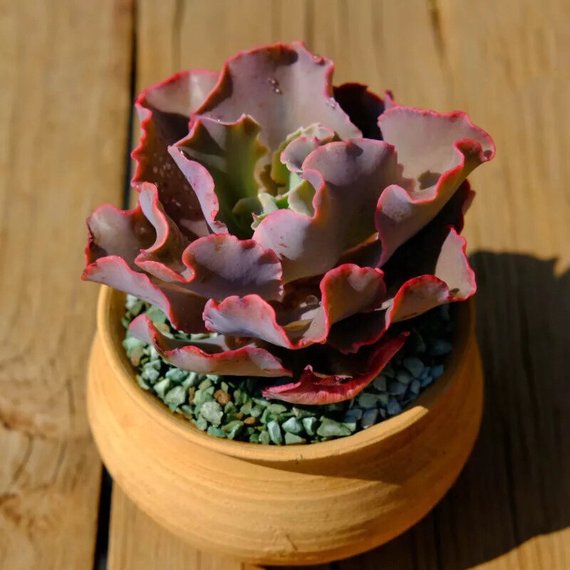Echeveria 'Takasago No Okina' belongs to the Crassulaceae family, specifically the Echeveria genus, and is a succulent plant. Its stem is robust, with leaves densely arranged in a rosette shape, round in appearance, and with large wavy folds along the edges. The color of the leaves ranges from green to reddish-brown, with new leaves being lighter and older leaves darker. It produces orange bell-shaped flowers.
Understanding the Characteristics of Echeveria 'Takasago No Okina':
Echeveria 'Takasago No Okina' thrives in full sunlight and prefers dry, warm climates with ample sunshine. It grows best in temperatures ranging from 18-28°C and, like other succulents, can withstand short periods of drought. However, it is not tolerant of high temperatures, which can hinder its growth during hot seasons. It should not be overwatered, as this can lead to root rot. It is relatively tolerant of cold temperatures but cannot withstand frost, which can slow down or halt its growth. It prefers partial shade and does not thrive in overly dark environments. It does not have strict soil requirements but grows well in loose, well-draining sandy loam.
Cultivation Methods for Echeveria 'Takasago No Okina':
Optimal Propagation Time: Echeveria 'Takasago No Okina' can be propagated through stem or leaf cuttings throughout the year.
Preferred Soil: The soil for Echeveria 'Takasago No Okina' should be well-draining, with the surface covered in clean gravel.
Moisture Requirements: The plant requires moderate humidity levels and should not be allowed to become too dry.
Optimal Growing Conditions for Echeveria 'Takasago No Okina':
Temperature: Echeveria 'Takasago No Okina' prefers temperatures between 15-25°C.
Light: It thrives in environments with ample sunlight, although during the summer, it may benefit from partial shading to avoid direct exposure to intense sunlight.
Precautions for Echeveria 'Takasago No Okina':
Fertilization: Fertilization during summer is unnecessary.
Watering: During the summer dormancy period, watering should be reduced or withheld to allow the soil to dry slightly. Watering can resume in mid-September when temperatures begin to cool down. Be cautious of rain during the summer rainy season to prevent root rot.
Potting: Echeveria 'Takasago No Okina' is a large plant and should be repotted every 1-2 years, with the new pot being 1-2 inches larger in diameter than the plant to promote growth.
Propagation: Echeveria 'Takasago No Okina' can be propagated through stem or leaf cuttings year-round.
Pest Control: Echeveria 'Takasago No Okina' is not prone to significant pest infestations.
Propagation of Echeveria 'Takasago No Okina':
Echeveria 'Takasago No Okina' can be propagated using stem or leaf cuttings, with both methods suitable throughout the year. For leaf cuttings, select healthy, plump leaves, allow them to dry in a shaded area until the wounds callous, then plant them in well-structured soil. Water lightly after planting, and follow the principle of watering only when the soil is dry, ensuring thorough watering when necessary. During the rainy season and winter, watering should be suspended, but occasional misting of the leaves is acceptable. Mature plants may require organic fertilizer during repotting every two years to promote growth. Stem cuttings are easy to root; select robust stems and plant them in moist soil without waterlogging.
